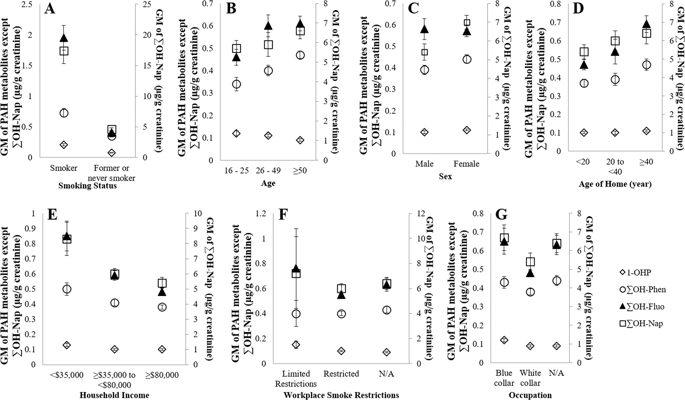当前位置:
X-MOL 学术
›
J. Expo. Sci. Environ. Epid.
›
论文详情
Our official English website, www.x-mol.net, welcomes your feedback! (Note: you will need to create a separate account there.)
The influence of demographic and lifestyle factors on urinary levels of PAH metabolites-empirical analyses of Cycle 2 (2009-2011) CHMS data.
Journal of Exposure Science and Environmental Epidemiology ( IF 4.5 ) Pub Date : 2020-02-17 , DOI: 10.1038/s41370-020-0208-4 Jennifer L A Keir 1 , Sabit Cakmak 2 , Jules M Blais 1 , Paul A White 1, 2
Journal of Exposure Science and Environmental Epidemiology ( IF 4.5 ) Pub Date : 2020-02-17 , DOI: 10.1038/s41370-020-0208-4 Jennifer L A Keir 1 , Sabit Cakmak 2 , Jules M Blais 1 , Paul A White 1, 2
Affiliation

|
Polycyclic aromatic hydrocarbons (PAHs) are a group of compounds formed during the incomplete combustion of organic matter. Several are mutagenic carcinogens; the magnitude of exposure can be assessed by examining urinary levels of PAH metabolites. Data from biomonitoring studies that record urinary PAH metabolite levels, as well as demographic and lifestyle information, can be used to investigate relationships between PAH exposure and variables, such as smoking status, workplace smoking restrictions, age, sex, household income, home age, and occupation. This study analysed creatinine-adjusted urinary PAH metabolite concentrations and questionnaire data from ~1200 individuals aged 16 years and older surveyed in Cycle 2 of the Canadian Health Measures Survey (CHMS). Statistical analyses revealed that smoking status, age, and sex are associated with urinary concentrations of a pyrene metabolite (1-OHP), phenanthrene metabolites (ΣOH-Phen), fluorene metabolites (ΣOH-Flu) and naphthalene metabolites (ΣOH-Nap). More specifically, smoking status, age and sex can collectively account for 30, 24, 52, and 34% of the observed variations in 1-OHP, ΣOH-Phen, ΣOH-Flu and ΣOH-Nap metabolites, respectively (p < 0.001). Analyses of non-smokers revealed weak but significant effects of age, sex, home age, and occupation on urinary levels of selected PAH metabolites (i.e., <7% of observed variation, p < 0.05). The unexplained variation in PAH metabolite levels is most likely related to diet, which was not examined. Although the results revealed significant relationships between urinary PAH metabolite levels and several lifestyle and/or demographic variables, robust examinations of selected effects (e.g., sex, home age, occupation) will require datasets that are balanced with respect to the other highlighted variables. The results can be used to identify remedial measures to reduce exposure and concomitant risk, and/or design follow-up studies to test hypotheses regarding the causes of exposure differences empirically related to sex, age, home age, and occupation.
中文翻译:

人口统计学和生活方式因素对 PAH 代谢物尿液水平的影响——第 2 周期(2009-2011)CHMS 数据的经验分析。
多环芳烃(PAHs)是有机物不完全燃烧过程中形成的一组化合物。有几种是诱变致癌物;可以通过检查尿液中 PAH 代谢物的水平来评估暴露程度。来自记录尿 PAH 代谢物水平以及人口统计和生活方式信息的生物监测研究数据可用于调查 PAH 暴露与变量之间的关系,例如吸烟状况、工作场所吸烟限制、年龄、性别、家庭收入、家庭年龄、和职业。本研究分析了在加拿大健康措施调查 (CHMS) 第 2 周期中接受调查的约 1200 名 16 岁及以上个体的经肌酐调整的尿 PAH 代谢物浓度和问卷数据。统计分析显示,吸烟状况、年龄、和性别与芘代谢物 (1-OHP)、菲代谢物 (ΣOH-Phen)、芴代谢物 (ΣOH-Flu) 和萘代谢物 (ΣOH-Nap) 的尿液浓度相关。更具体地说,吸烟状况、年龄和性别可分别占观察到的 1-OHP、ΣOH-Phen、ΣOH-Flu 和 ΣOH-Nap 代谢物变化的 30%、24%、52% 和 34%(p < 0.001) . 对非吸烟者的分析表明,年龄、性别、家庭年龄和职业对选定的 PAH 代谢物的尿液水平有微弱但显着的影响(即,<7% 的观察到的变化,p < 0.05)。PAH 代谢物水平的无法解释的变化很可能与饮食有关,但未对其进行检查。尽管结果揭示了尿 PAH 代谢物水平与几种生活方式和/或人口统计变量之间的显着关系,对选定影响(例如,性别、家庭年龄、职业)的稳健检查将需要相对于其他突出变量保持平衡的数据集。结果可用于确定减少暴露和伴随风险的补救措施,和/或设计后续研究以检验与性别、年龄、家庭年龄和职业相关的暴露差异原因的假设。
更新日期:2020-02-17
中文翻译:

人口统计学和生活方式因素对 PAH 代谢物尿液水平的影响——第 2 周期(2009-2011)CHMS 数据的经验分析。
多环芳烃(PAHs)是有机物不完全燃烧过程中形成的一组化合物。有几种是诱变致癌物;可以通过检查尿液中 PAH 代谢物的水平来评估暴露程度。来自记录尿 PAH 代谢物水平以及人口统计和生活方式信息的生物监测研究数据可用于调查 PAH 暴露与变量之间的关系,例如吸烟状况、工作场所吸烟限制、年龄、性别、家庭收入、家庭年龄、和职业。本研究分析了在加拿大健康措施调查 (CHMS) 第 2 周期中接受调查的约 1200 名 16 岁及以上个体的经肌酐调整的尿 PAH 代谢物浓度和问卷数据。统计分析显示,吸烟状况、年龄、和性别与芘代谢物 (1-OHP)、菲代谢物 (ΣOH-Phen)、芴代谢物 (ΣOH-Flu) 和萘代谢物 (ΣOH-Nap) 的尿液浓度相关。更具体地说,吸烟状况、年龄和性别可分别占观察到的 1-OHP、ΣOH-Phen、ΣOH-Flu 和 ΣOH-Nap 代谢物变化的 30%、24%、52% 和 34%(p < 0.001) . 对非吸烟者的分析表明,年龄、性别、家庭年龄和职业对选定的 PAH 代谢物的尿液水平有微弱但显着的影响(即,<7% 的观察到的变化,p < 0.05)。PAH 代谢物水平的无法解释的变化很可能与饮食有关,但未对其进行检查。尽管结果揭示了尿 PAH 代谢物水平与几种生活方式和/或人口统计变量之间的显着关系,对选定影响(例如,性别、家庭年龄、职业)的稳健检查将需要相对于其他突出变量保持平衡的数据集。结果可用于确定减少暴露和伴随风险的补救措施,和/或设计后续研究以检验与性别、年龄、家庭年龄和职业相关的暴露差异原因的假设。



























 京公网安备 11010802027423号
京公网安备 11010802027423号